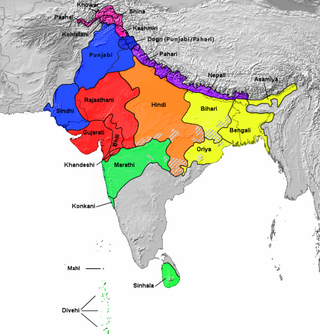
The Indo-Aryan languages are a branch of the Indo-Iranian languages in the Indo-European language family. As of the early 21st century, they have more than 800 million speakers, primarily concentrated in India, Pakistan, Sri Lanka, Bangladesh, Nepal and Maldives. Moreover, apart from the Indian subcontinent, large immigrant and expatriate Indo-Aryan–speaking communities live in Northwestern Europe, Western Asia, North America, the Caribbean, Southeast Africa, Polynesia and Australia, along with several million speakers of Romani languages primarily concentrated in Southeastern Europe. There are over 200 known Indo-Aryan languages.

Odia is an Indo-Aryan language spoken in the Indian state of Odisha. It is the official language in Odisha, where native speakers make up 82% of the population, and it is also spoken in parts of West Bengal, Jharkhand, Andhra Pradesh and Chhattisgarh. Odia is one of the many official languages of India; it is the official language of Odisha and the second official language of Jharkhand. The language is also spoken by 700,000 people in Chhattisgarh.
Chhattisgarhi (छत्तीसगढ़ी) is an Indo-Aryan language spoken by approximately 16 million people from Chhattisgarh, Odisha, Madhya Pradesh and Maharashtra in India. It is the official language of Chhatisgarh. It is grouped within the Eastern Hindi languages and is closely related to Awadhi, Bagheli and Odia but is counted by the Indian national census as a dialect of Hindi.

The Northern Indo-Aryan languages, also known as Pahāṛi languages, are a proposed group of Indo-Aryan languages spoken in the lower ranges of the Himalayas, from Nepal in the east, through the Indian states of Jammu and Kashmir, Uttarakhand, Himachal Pradesh and Punjab(not to be confused with the various other languages with that name) was coined by G. A. Grierson.

Chittagonian is an Indo-Aryan language spoken in parts of the Chittagong Division in Bangladesh. Its speakers identify with Bengali culture and the Bengali language. Chittagonian and Standard Bengali are not inherently mutually intelligible, although it is considered as a nonstandard Bengali dialect. Chittagonian is considered to be a separate language by some linguists. It is mutually intelligible with Rohingya and to a lesser extent with Noakhailla. It is estimated (2009) that Chittagonian has 13 million speakers, principally in Bangladesh.
Magadhi Prakrit (Māgadhī) is of one of the three Dramatic Prakrits, the written languages of Ancient India following the decline of Pali and Sanskrit. It was a vernacular Middle Indo-Aryan language, replacing earlier Vedic Sanskrit.
Lahnda, also known as Lahndi or Western Punjabi, is a group of north-western Indo-Aryan language varieties spoken in parts of Pakistan and India. It is defined in the ISO 639 standard as a "macrolanguage" or as a "series of dialects" by other authors. Its validity as a genetic grouping is not certain. The terms "Lahnda" and "Western Punjabi" are exonyms employed by linguists, and are not used by the speakers themselves.

Halbi is an Eastern Indo-Aryan language, transitional between Odia and Marathi. It is spoken by at least 766,297 people across the central part of India.

Khetrānī, or Khetranki, is an Indo-Aryan language of north-eastern Balochistan. It is spoken by the majority of the Khetrans, a Baloch tribe that occupies a hilly tract in the Sulaiman Mountains comprising the whole of Barkhan District as well as small parts of neighbouring Kohlu District to the south-west, and Musakhel District to the north. The ethnic Khetran population found to the east in the Vehova Tehsil of Taunsa Sharif District of Punjab instead speak Saraiki. Alternative names for the language attested at the start of the 20th century are Barāzai and Jāfaraki.
Ahirwati is an Indo-Aryan dialect of India. It is spoken within the Ahirwal region located to the south-west of the capital Delhi. It belongs to the Rajasthani language group and is commonly taken to be a dialect of Mewati, but in many respects it is intermediate with the neighbouring varieties of Bangru and Bagri, and is especially close to Shekhawati.
Pahari, or Pahadi is an ambiguous term that has been used for a variety of languages, dialects and language groups, most of which are found in the lower Himalayas.
The Punjabi dialects and languages or Punjabic are a series of dialects and languages spoken around the Punjab region of Pakistan and India with varying degrees of official recognition. They have sometimes been referred to as the Greater Punjabi macrolanguage. Punjabi may also be considered as a pluricentric language with more than one standard variety.

The Eastern Indo-Aryan languages, also known as Māgadhan languages, are spoken throughout the eastern region of the subcontinent, which includes Bihar, Uttar Pradesh, Jharkhand, Bengal region, Tripura, Assam, and Odisha; alongside other regions surrounding the northeastern Himalayan corridor. Bengali is official language of Bangladesh and the state of West Bengal, Tripura and the Barak valley of Assam while Assamese and Odia are the official languages of Assam and Odisha, respectively. The Eastern Indo-Aryan languages descend from Abahattha, which descends from Magadhan Apabhraṃśa and ultimately from Magadhi Prakrit.

Bhadarwahi is an Indo-Aryan language of the Western Pahari group spoken in the Bhaderwah region of Jammu and Kashmir, India.

Angika is an Eastern Indo-Aryan language spoken in some parts of the Indian states of Bihar and Jharkhand, as well as in parts of Nepal.

Thaḷī is a Lahnda dialect spoken in parts of the Pakistani provinces of Punjab and Khyber Pakhtunkhwa. It has a widespread area, starting from Tank to Muzzafargarh on the eastern end of the Indus River and from Bannu running down to D I khan at the western end of the Indus River. It is classified as a northern dialect of Saraiki, although it has also been described as transitional between Shahpuri and the central Saraiki Multani dialect. Its name derives from the Thal Desert.
Powari is an Indo-Aryan language spoken primarily in Madhya Pradesh and Eastern Maharashtra. It belongs to the Hindi subgroup. However, further classification is difficult to determine. Despite the name, the majority of ethnic Powar people, who amount to approximately one million people, approximately only about 30% are native speakers of Powari. However, about 70 % of Powar community members can speak & write Powari language.
Jatki, Jadgali, and other related terms have sometimes been used to refer to one or another of the Indo-Aryan languages spoken in Balochistan and neighbouring parts of Sindh and Punjab. These terms have their origin in the association between speakers of those languages and either the Jats or, more broadly, other settled agriculturalist communities.
Rangri may refer to the following Indo-Aryan dialects:
Desia, also Desiya or Desia Odia or Koraputi Odia or Southwestern Odia, is an Indo-Aryan language variety spoken in Koraput, Nabarangpur, Rayagada, Malkangiri districts Odisha and in the hilly regions of Vishakhapatnam and Vizianagaram districts of Andhra Pradesh. The variant spoken in Koraput is called Koraputia.









